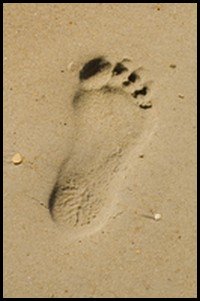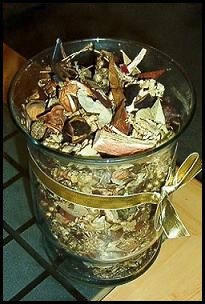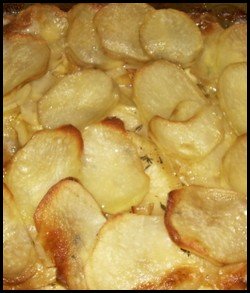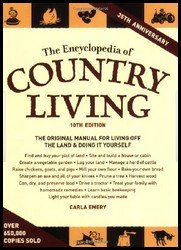

Country Living E-zineIssue 9APRIL 2009
"The foolish man seeks happiness in the distance, the wise grows it under his feet." ~ James Oppenheim
Editorial :Welcome to Country Living and Farm Lifestyles' e-zine #9 Since I sent out my last newsletter to everyone, a lot has happened on a personal level. I spent 2 weeks in Australia with my parents this month celebrating their 60th wedding anniversary, and my husband and I are trailing a little behind, with our 25th wedding anniversary just yesterday. For those of you who visit quite often you will have noticed that we have revamped our home page yet again, and I really like the look at present. Feel free to write in our Guest Book and tell us what you think! Look out for some more changes in the next few months as we will be adding a third column in the not too distant future. New additions to the website since the last newsletter include an increase in Twitter followers now standing at 207. If you are not on twitter, come and join us and look for us @Countryfarm. FOR THE FARM FOR SUSTAINABLE LIVING: * Growing Organic Tomatoes Successfully * Homemade Beauty Products & Cosmetics FOR GREEN LIVING: FOR THE KITCHEN: * Jam Recipes and Instructions * Jelly Recipes and Instructions
This Month's Articles: What is your Eco-Footstep? Why should we be worried about the way we live our lives and the impact it is having on the earth? Are we too big for our boots? Are we leaving a carbon-footprint too big for our own good? "We have plenty of open spaces and unused land", I hear your say. Yes we do, but our ecological footprint that is dictated to by what we consume in the form of utilities, food and travel is getting bigger and bigger. To the point that with our current lifestyles Australians need in excess of 7.7 hecatares of land to sustain them and Americans need 9.6 hectares. And worst of all, I live in a country where we need 11.8 global hectares per person!
And what should we be using? With the current population, we should only be using 1.8 hecatares of land. If current population and consumption trends continue, by the mid 2030s we will need the equivalent of two earths to support us. That's a sobering fact, considering we only have one. It stands to reason then, that we cannot keep on living the same lifestyle if we want to conserve resources for the following generations. So, how is our ecological footprint made up, and how can we reduce it? ANIMALS: - Meat and Animal Products The biggest component is made up of meat and animal products at 33%. Even if you are a vegetarian, you would be using more space than a vegan. Production of a single 150 gram serve of meat is estimated to use over 200 litres of water and create 5 kilograms of greenhouse pollution. In addition, to produce one pound of meat, an animal must consume tens of times that weight in grain. Therefore, the land on which the grain is grown is counted in the footprint. This grain must also be shipped and the meat processed, which adds to the growing footprint. Solution: - By eating one less serving of meat a week, in a year you would save up to 10, 000 litres of water and 300 kg of greenhouse pollution! CLOTHING: Clothing make up 14% of the footprint. Do you buy clothing from recycled materials? How often do you buy new clothes? And have you ever thought about how much water it takes to produce your clothes per year? Well, 150 000 litres to be exact which is made up of the amount of water used in its production, manufacture and transportation. That doesn't include the kilograms of pesticides and fertilizers taken to produce the material. Solution: - Buy fewer clothes and rather repair and mend rather than replacing. HOUSE CONSTRUCTION: 11% here! Solution: - We all need shelter, but when renovating, buying new or an existing property consider how you can improve its water and energy consumption and go for a greener build. Use local building materials with recyclable content. Don't use fossil fuels and attach water tanks to your roof to store rainwater for your garden. Use solar power and wind turbines. By buying near public transport you can leave your car in the garage and save even further. OTHER SERVICES: 10% here! These include your plumbers, electricians, architects and landscapers. Solution: - Employ green plumbers, green electricians and green architects who are sympathetic to sustainable and green building. When you have your garden landscaped do it with organic material and leave out the chemical fertilizers. TRAVEL & ACCOMMODATION: 8% here! Solution: - Limit your plane travel and take eco-holidays where the owners are responsible towards the environment and are looking to provide low-impact holidays. Remember if you are camping or on a picnic to light cooking fires safely, and remove all rubbish when you are done. VEGETABLE PRODUCTS: 8% here too. Going to buy frozen and canned vegetables has taken more resources than buying fresh produce from your local farmer or growing your own. Solution: - If you have a garden or even a balcony, grow your own vegetables and herbs. Use plenty of manure and organic sprays to kill those bugs and beasties and support your local farmer at your local farm shop or farmers' market. MANUFACTURED GOODS: 7% Solution: - Think of renting before you buy. This includes power tools, camping equipment, lawnmowers and motorized gardening equipment. TRANSPORT: Cars and road transport make up 6% of the carbon footprint and are the biggest contributors to greenhouse emissions. For every litre of gas or petrol you use, you emit 2.5 kg of greenhouses gases into the atmosphere. Solution: - Car pool, take public transport, buy locally and even cycle or walk to work if you can. By cycling or walking you are getting the additional benefit of excercise. FURNITURE & SMALL APPLIANCES: 2% here. Solution: - Do you really need the latest deep-frier or pop-corn maker? Can you not make do with a deep pot for both? Limit your small appliances and see if you can buy wooden furniture that has come from well-managed forests that are sustainable. Stay away from timber that has come from rain-forests and the like. PERSONAL CARE PRODUCTS: 1% here. You would be shocked to know that with all the additional chemicals, frangrances and colours added to beauty products and toiletries these days, the average woman could end up with 2 kg of synthetic chemicals in her body through skin absorbsion. Solution: - Read our section on natural beauty products (details above) to see how you can make cosmetics naturally and safely for all your beauty needs. FINAL OUTCOME: - A sustainable lifestyle is one that does not use more natural resources at a faster rate than the Earth makes available. We should make wise decisions and always try to recycle where possible. We should all be aiming towards a more sustainable lifestyle. Craft for the Month: Making Potpourri Why buy expensive and chemical-laced air-fresheners when you can make your own potporri from your new spring blooms? 1. Gather a few flowers each time you go out into the garden and place them on a wire rack in a warm place to dry. 2. Pick full-blown rose petals and use these as your base for your potpourri. Dry as above. 3 tsp ground cinnamon 1 tbsp ground orris root 1 whole nutmeg, grated 40 drops lavender oil 40 drops rose geranium oil 10 drops mandarin oil 7 1/2 cups dried flowers of your choice Mix the cinnamon, orris root and nutmeg together in a pestle and mortar. Add the essential oils and blend to a moist powder. Measure out the petals and flowers into a large bowl and add the oil and spice mixture thoroughly. Place the potpourris mixture into a large lidded glass jar for about 6 weeks to cure. Shake it gently from time to time. After 6 weeks it is ready for use. Recipe for the Month: Potatoes in a Beer Sauce This is a delicious Italian recipe that you will use again and again! 1 1/2 pounds potatoes, thinly sliced 3 white onions, thinly sliced 2 ounces pancetta, thinly sliced salt 1 1/2 cups light beer 1 cup cream Heat the oven to 400 degrees F. Place the potatoes and onions in large pot. Add the pancetta (bacon can be used as a substitute). Season with salt. Pour in the beer and the cream. Place the pot over a medium heat and bring to the boil. Remove from the stove and transfer to an oven-proof dish and place in the oven for 1 hour and 30 minutes, or until the fork-tender. While the potatoes are cooking, stir them lightly with a fork or spoon every few minutes and make sure that most of the liquid has evaporated. Book Review: The Encyclopedia of Country Living 
Carla Emery was a national treasure and this book ensures her legacy. This is simply the most informative book ever written on country living, the next best thing to having a live-in grandmother who knows everything there is to getting homegrown food from dreams to dinner plates plus nearly anything else you need to know. Begun as a 12-page table of contents for a recipe book in 1969, the present ninth edition has 858 pages of far more than recipes. Veggies, vines, trees, grains, poultry, goats, cows, bees, rabbits, sheep, pigs. Planning, nurturing, harvesting, preserving, preparing. Flipping pages at random finds starting transplants, breads leavened with eggs and beating, speeding up tomato sauce-making, harvesting herbs, making cider, managing an existing stand of trees, root cellar storage, soap making, brooding chicks, secrets to safe cattle handling, cultured buttermilk, cooking on a wood stove, jams and jellies, making a wool quilt. I use my "Carla book" constantly. If your budget or bookshelf has room for only one book, this is the book to buy. Yes, even before you buy mine. Review by: GENE GERUE "Author, Find Your Ideal Country Home" You can purchase this wonderful book through our Country Corner Book Store. We have many other books on this subject, along with many others that may be of interest. So feel free to step inside and come and browse. Well, we hope that you have enjoyed reading the ninth issue of our e-zine, as much as we had fun writing it. We also hope that you will stay with us for a long time, visit our web site for updates, and feel free to contribute to the many forums we have created especially for you. Until next time! Philip & Kathryn Bax Country Living and Farm Lifestyles https://www.countryfarm-lifestyles.com Your Gateway to Rural Dreams! Visit us for Country Crafts, Country Decor, Country Cottages, Farm Shops, Farming & Gardening Articles and general issues dealing with Rural & Country Life. New! CommentsDo you have something of value to add? Leave me a comment in the box below. |
